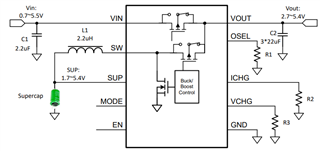Hi,
I am designing a back-up power circuit including a primary battery and a supercapacitor.
Main use case for the supercap is to supply power while replacing the battery.
Current design is a cascade: first stage running on battery and second on supercap.
Now the leakage current of the supercap consumes a lot of juice from the battery.
Is there a better way to design, e.g can two TPS61094 chips be connected in parallel?
Configuring different output voltage decides priority?



